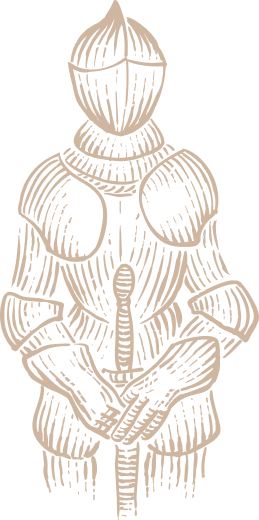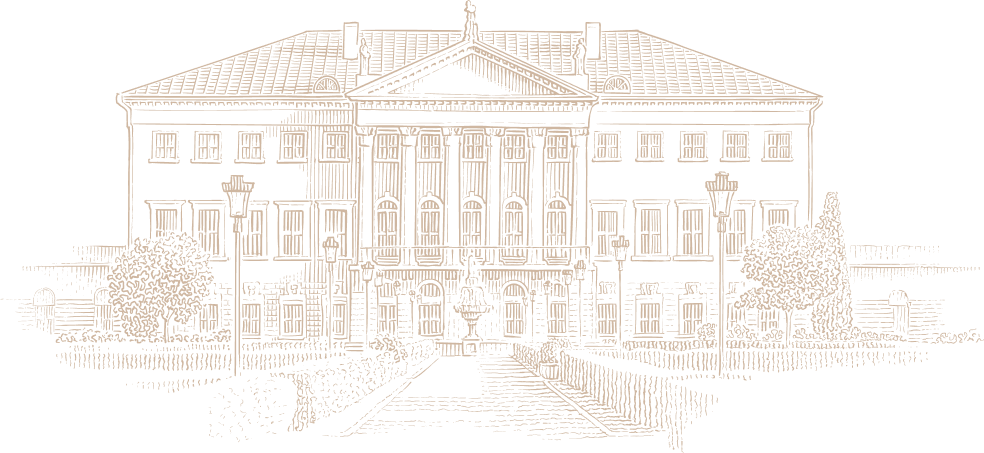
 Русская версия
Русская версия Русская версия
Русская версия
A manor house of the nobility is a typical Russian architectural and cultural heritage. Something that is peculiar to Russian culture and Russian traditions.
The word "manor house" comes from the verb "to plant" or "to garden" and represents individual settlements. Each of them includes a complex of residential, commercial and garden buildings, united into a single whole. However, this term also describes the first Old Russian settlements, but when we mention the word "manor house", we rather think of classical, aristocratic manor houses, especially country ones.
Manors outside the city are a special phenomenon in culture, a worldview of aristocrats, a model of the world, a state with its own lords and subjects, with its own economy and crafts, with its own entertainment, theatres and orchestras.
The golden age of the Russian country estate was from the 1762 Decree on the Liberty of the Nobility, issued by Peter III, to the 1861 Manifesto on the Emancipation of the Peasants, issued by Alexander II.
As a rule, manor houses were built on the banks of a river or a pond, with the lord's house as their centre. A long alley framed by trees led from the front gate to the main house. Around the main house were built outhouses, outbuildings, obligatory church, park and orchards. And further away - farmers' huts, cattle yards. And all this formed a single organism.
A few kilometres north-east of Moscow, on the banks of the Lyuboseevka River and the Barskoye Ponds, stretches the vast architectural and park ensemble of the Grebnevo Estate.
It is truly a jewel of the Moscow suburbs, with picturesque surroundings, extraordinary architecture and a fascinating history.
The first mention of the site dates back to the 14th century. The owner of the Grebnev lands, Prince Ivan Kalita of Moscow, and the Murza Chet are associated with its history.
The Murza and his army of thirty thousand men travelled from the Golden Horde to Moscow. During one of his halts, the Horde nobleman prayed to God for healing from a disease that had long tormented him. In a dream he saw the Mother of God with the Apostle Philip and the holy martyr Hypatius. After waking up, Chet was surprised to find that he was completely cured. Murza Chet converted to Orthodoxy and was baptized with the name Zacharias. Ivan Kalita presented Zakhary-Chet with chambers in the Kremlin and vast lands, including the village of Grebnevo, formerly called Chetrekovskoe in honour of the Tatar nobleman.
Later, in gratitude to God for the miraculous healing, Murza Chet founded the famous Holy Trinity Ipatiev Monastery.
Many historical figures are associated with the manor house. The Grand Duke of Moscow and Vladimir, the conqueror of Mamai, Dmitry Donskoy, to whom, according to legend, the miraculous icon of Our Lady of Grebnev was presented here.
Prince Vladimir the Brave, the owner of the manor, and voivode Dmitry Bobrok-Volynsky, who decided the outcome of the battle in favour of the Russians in the Battle of Kulikovo.
In Ivan III's time, in 1478, the land belonged to the noble voivode Vasily Grebenka-Shuisky, who gave his name to the present village.
In the following centuries, the manor was owned by representatives of noble families: the Vorontsovs, the Trubetskys, the Golitsyns and the Bibikovs. In 1755, Grebnev was owned by Princess Ekaterina Golitsina, one of the most educated women of her time, an outstanding harpsichordist of the 18th century. Possessing a beautiful voice and an excellent vocal school, the princess, according to contemporaries, could compete with the best opera virtuosi of Italy. In Paris she joined the famous "salon of Madame Joffrin" (Marie Therese Rohde), which brought together all the great minds of France: the philosophers Dalembert, Holbach, Diderot, Marmontel, writers, artists and theatre personalities.
Later, the manor passed into the hands of Princess Anna Trubetskoy, the mother of the famous poet Mikhail Kheraskov. In 1779, Gavriil Derzhavin, a friend of Kheraskov's and a frequent visitor to the area, wrote a poem, The Key, mentioning the spring at Grebnev:
"May your honour pass through all cities
Like an echo from the mountains through a dense forest:
The creator of the immortal Rossiada,
Sacred Grebenev's key,
Thou hast watered the water of poetry."
In 1774 the estate was inherited by the son of Anna Trubetskoy, Nikolai Trubetskoy, the founder of the secret lodge "Harmony" and head of the Moscow lodge "Osiris". Trubetskoy had influence and status in society and befriended a major figure of the era of the Russian Enlightenment and the Masonic movement - Nikolai Novikov.
In 1781, Gavriil Bibikov, an associate of Alexander Suvorov, brother-in-law of Mikhail Kutuzov and brother-in-law of Alexander Bibikov, commander-in-chief of the troops at the suppression of the Pugachev Uprising, became the owner. It was Bibikov who erected the magnificent estate ensemble in the style of Russian classicism, including residential and outbuildings, a French garden, an English park, and the Church of the Grebnev Icon of the Mother of God, built by Ivan Vetrov, a pupil of Matvei Kazakov.
The recollections of Gavriil Bibikov's granddaughter Catherine Raevskaya give an idea of life in Grebnev: "The house there was huge, stone, surrounded by large gardens, among which huge ponds were dug with several islands on them, and gardens were also laid out on the islands and arbours were built...When guests came from the neighbourhood or from Moscow, then they harnessed rulers, rode all the company along the broad garden paths, ferried to the islands and drank tea in the arbour... Grandfather's house in the village of Grebneva had a theatre built in the garden, with a stage, wings and all kinds of adapted scenery. An orchestra of serf musicians played there, and some ballets were performed, in which serf dancers appeared, and music teachers and a choreographer were sent to teach them. With the manners of the eighteenth century these amusements seemed quite natural".
According to another granddaughter, Elisabeth Megden: 'Old Iogel, whom all Moscow knew, was sent out by his grandfather from France to arrange a ballet at his house near Moscow'. This is about the famous dancer Pyotr Andreyevich Iogel, and it is his balls that Leo Tolstoy describes in his novel War and Peace as the most cheerful. According to legend, Pushkin met Goncharova at Iogel's ball.
In the history of those years there was a legend that the local Barskoye ponds were dug by the convicts - captive associates of the famous Yemelyan Pugachev, the leader of the 1773-1774 peasant revolt, "a riot without reason and merciless". But no - for the first time the pond is mentioned in the "Census books of the Moscow State in the 16th century" and in the 17th century census books, with details of the dam and the mill.
Consequently, the pond originated here quite a long time ago, and the "Pugachevites" clearly had nothing to do with it.
At the beginning of the 19th century, Grebnevo was rebuilt by the new owners Alexander and Sergey Golitsyn. The reconstruction was supervised by the architect Nikolai Deryugin, and he and Ignatius Oldelli later built a new church, presumably to a design by Andrei Voronikhin. Domenico Gilardi was involved in the decoration of the interior. This is the appearance of the manor house that has survived to the present day.
In the middle of 19th century the new owners, merchants Panteleevs, Kondrashovs and Fedotovs housed textile, silk weaving and artificial wool factories in the manor buildings at different times. The merchants Kondrashovs' factory products were the best, they successfully participated in all-Russian and world exhibitions.
In 1913, the estate was bought by the well-known Moscow doctor Fyodor Grinevsky, a third cousin of Russian writer Alexander Grin. Henceforth the manor became the private sanatorium Grebnevo near Moscow. Guests of the sanatorium included the actor Alexander Usachev, the historian Dmitry Tsvetaev, the Russian and Soviet actor Leonid Leonidov, the academician Vladimir Palladin, the Silver Age poets Konstantin Balmont and Sergey Yesenin, and many others.
After the revolution of 1917, the mansion was nationalised. In Soviet times there was a hospital, a technical college, a research institute, and a cultural centre.
But it was not time and social cataclysms, but the fire in 1991 destroyed the architectural pearl of Moscow suburbs. Grebnevo fell into a state of extreme desolation, although interest in the former manor house was not lost: filmmakers shot films here and artists staged exhibitions.
When the estate seemed to be in danger of total destruction, in 2018 it was purchased by the well-known businessman, social activist and musician Andrei Kovalev.
Since then, Grebnevo has gradually started to revive and is now a weekend destination for visitors. Festivals, concerts and excursions are held here. On the banks of the picturesque pond, temporary cabins for accommodation, a gazebo, the Trubetskoy Hall grand marquee and a boat station have appeared.
Today, work is underway to restore the manor. In the future, the goal is to create Russia's largest architectural, historical, cultural, educational and entertainment cluster with an area of over 300 ha, with museums of painting, knight armour, carriages, antique cars and agricultural machinery.
Andrey Kovalev, a businessman, public figure and musician, bought the Grebnevo Estate for 80.1 million roubles. The new owner of the manor aims not only to fully restore the manor house, but also to make Grebnevo the centre of the country's history and culture.
"Despite the complexity of the task at hand, I will not just restore the manor house, but will restore its grandeur and preserve and enhance its historical significance for the whole country!"
A lot of work has already been done in the last year - the estate has come to life! Grebnevo is now a huge green park with a children's area, land and water entertainment. The farmstead regularly hosts mass cultural events for families, concerts and business conferences.



